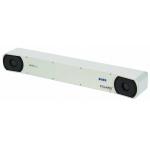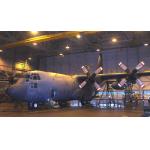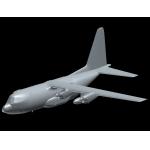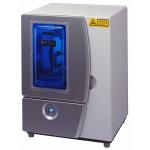3D Digitizers Hard at Work
Expanding to new heights, widths, depths and nuances, freeform 3Dcapture systems are improving our way of design, business, and medicine.
Latest News
July 1, 2006
By Pamela J. Waterman
If there an industry that still doesn’t use digitizing systems to capture 3D CAD data? From surgical operating rooms to nuclear reactors, in manufacturing plants and art studios, users of all skill levels are not only embracing but pushing system capabilities beyond traditional reverse engineering. Here’s a look at applications that demonstrate this field’s versatility and usefulness.
Focusing Fuzzy Pet Scan Data
You might be more familiar with CAT scans than PET scans, but the latter often allows more detailed medical analysis than a CAT or CT (computer-aided tomography) scan alone. PET refers to positron emission tomography and its cameras detect faint gamma-ray emissions from the organs of patients injected with a radiopharmaceutical tracer to distinguish between benign and malignant disorders (or between living and dead tissue). The benefit is it can detect abnormalities in cellular activity generally before any anatomical (CAT-detectable) change.
The procedure is somewhat similar to that of CAT and MRI scans, though the patient lies flat on a stationary bed positioned beside the imaging cameras. Problems with head-scan resolution can occur if patients slowly readjust their head position—not unreasonable—during what can be a two-hour procedure. A sudden movement, such as during a sneeze, can be overlooked, but a gradual overall movement blurs the final exposure.
 |
| The Northern Digital Polaris |
› › The Northern Digital Polaris optical measurement system combines simultaneous tracking of both wired and wireless tools.
To compensate for this, Peter Bloomfield, while a researcher at Imaging Research Solutions, Ltd. in Hammersmith Hospital, London, developed a motion-tracking system that incorporated a Northern Digital Inc. Polaris optical measurement system. Bloomfield devised a square Plexiglass plate attached to a neoprene cap as the base for a tracking device. It looks somewhat like a graduation mortarboard that the patient can wear with minimal discomfort while resting on the bed. Attached to the plate are four passive reflective markers, in plain view of the infrared emitters of the Polaris system while the patient is being scanned. The Polaris system monitors the patient’s head in space, triangulating 3D positional data synchronized to the PET data stream within 1 millisecond, and produces correlated motion-corrections that maintain the high-resolution imaging.
Safer Inspections in Nuclear World
Inspecting a facility full of pipes, control circuits, motors, and seals is a demanding job when the building is 135 feet in diameter and almost twice that height. Add in the fact that inspection personnel would be exposing themselves to radiation, and the job becomes worthy of a rethink to find that better way. Atomic Energy of Canada Ltd. (AECL) turned to 3D digitizing to do just that.
As both the designer and builder of many of the world’s top-performing nuclear reactors, AECL also delivers support services for the industry, including performing yearly plant maintenance and inspection. Of the many tasks involved, a so-called walkdown inspection is part of a critical audit to verify that each part of the system is built and maintained using the exact safety-approved parts called for in specifications. This task used to involve multiple engineers in protective clothing climbing, measuring, and photographing, all the while monitoring their radiation exposure time.
AECL discovered that a FARO Laser Scanner LS system could generate all the images necessary for off-site viewing, in far less time and using far fewer people actually procuring data. Designed for large-system applications, the LS has a range of 80 meters and can scan a 360-degree swing with a 320-degree vertical sweep. At typically 28-million pixels per scan, the laser system generates images that function as high-resolution photos.
By planning the shot-layouts ahead of time, the scans go quickly; one application required just four days of on-site work. Afterward, FARO software stitches the scans together into a single virtual environment on the desktop in which engineers can move, change directions, magnify, and inspect details as minute as whether a wall is plumb or to identify the serial number on a junction box. Typical person-hours in the actual reactor environment have been cut from thousands to less than a hundred, greatly improving safety for all involved.
Great Impressions Lead to Clear Solutions
Whether in the business of making hearing aids or clear, slip-on orthodontic “braces,” digital technology is helping medical professionals respond faster and more precisely to patient needs. To custom-fit a hearing aid, for example, an audiologist makes a soft impression of the ear’s internal shape, creating the master pattern for building the final device. While 3D digital data has already been used by both the medical and dental fields for building rapid prototype/ freeform parts for years, creating that data up front is becoming easier thanks to an automated, turnkey system developed by Genex Technologies.
Based on visible-light camera technology, the Genex 3D Digitizer includes the Genex Rainbow 3D Imaging system, an optimized computer, a precise robotic motion stage, and 3D Mosaic software. After placing a mold in the scanning compartment, a technician clicks once to start a sequence of imaging and data-merging that produces a full CAD model of the mold, suitable for the next step in custom manufacturing. Mosaic tools include display, measurement, editing, and output options.
Genex Technologies offers two targeted systems, the Dental and EI (Ear Impression) 3D Digitizers. Polymesh, a Providence RI partner, is a current user of the EI version.
Large Aircraft, Small Timeframe
A full-scale Falcon 20 aircraft, designed for parabolic flight paths to create up to 22 seconds of zero-G conditions, measures over 56 feet long with almost exactly the same wingspan. The operator of this particular jet, the National Research Council (NRC) of Canada’s Institute for Aerospace Research, wanted to digitize the exterior and capture its “as built” conditions to coordinate with simulations and inspections. However, NRC would only hand over the aircraft to a scanning team for two-and-a-half days, and it wanted on-surface point-cloud data versus previously acquired sparse off-set data.
 |
| Image courtesy Capture 3D. |
‹ ‹ Capture 3D’s ATOS II optical scanning system has been used to create 3D digital models of objects as large as a Falcon 20 jet and this C130 transport plane. Note the guy standing on top of the C130.
Capture 3D stepped up to the plate and used a two-phase data acquisition process. Since the aircraft was so large, the first step involved placing markers approximately one foot apart across the surface as reference points, then taking multiple pictures around the aircraft with a handheld high-resolution camera. These images were automatically triangulated within Capture 3D’s TRITOP Digital Photogrammetry system to produce a global reference file.
To capture the detailed imagery, the team brought in a Dual 1.3 Mpixel ATOS II Optical Scanning system mounted on a cherry picker. Based on structured light patterns and variable measuring-volume envelopes, the system’s resolution could be adjusted to ensure required feature capture. Scans were automatically positioned and merged to match up with TRITOP data, and verified in real-time for completeness. Symmetry permitted scanning just one side of the Falcon 20 completely, then checking several of the corresponding far-side points to allow accurate model-mirroring.
 |
| Image courtesy Capture 3D. |
› › This is the completed scan of the C130 transport, based on Capture 3D’s ATOS II imaging system.
The tight time-frame and size of the aircraft made the job a challenge, but Capture 3D was able to generate the necessary data density for creating the desired STL surface models and exceeded the customer’s expectations. In fact, the process worked so well it has been applied to a C130 transport aircraft with more than twice the wingspan.
Keeping Parade Balloons Afloat
Helium inflatables are guaranteed eye-catchers, whether a simple, 20-foot soda can or an intricate, 40-foot-tall Macy’s Thanksgiving Day Parade character. But delivering the aerodynamics behind the whimsy was once a huge task for specialty manufacturer Aerostar International. For years the company draped patterns manually on a small model, flattened out the small paper sections on an opaque projector, and pulled the projector forward and back until the image on a wall seemed the correct size for a hand-drawn enlargement.
The resulting full-scale balloon construction could be as much as 10 percent off the original plan, creating errors in the center of buoyancy and requiring extensive hand-sewing wizardry to correct. Such problems cost time and money, especially since the products tended to be one-of-a kind. These considerations led Aerostar to consider 3D data capture, particularly for organic shapes. They chose a MicroScribe mechanical-arm, touch-probe digitizer system from Immersion.
Now Aerostar’s team of four engineers and an artist have the choice of drawing gore lines (tapered sections of fabric) on the small physical model, or on the CAD model itself, using the MicroScribe to generate dimensional data that provides accuracy of one-sixteenths of an inch across the full-size patterns. They estimate a 10 to 20 percent savings in design costs, and have discovered the additional benefit of accurately mating their 3D models to other companies’ structural models when designing inflatable show-type (ground) products.
Contributing Editor Pamela J. Waterman is an electrical engineer and freelance technical writer based in Arizona. Send your comments about this article through e-mail by clicking here. Please reference “3D Digitizers, August 2006” in your message.
Roland Technology Tackles TV Mystery Plot
In a March episode of NBC television’s Crossing Jordan, construction workers dug up the bones of a baby girl. Discovering the baby’s identity proved a daunting task, even for the show’s quirky forensics expert Dr. Nigel Townsend. Fortunately, Townsend had a Roland LPX-250 3D laser scanner handy. Even though tests showed the baby was buried some 18 to 20 years before, he was able to scan the skull and match its 3D file with a photo of the missing child. Ultimately, Townsend was able to determine that the baby died from natural causes.
 |
| The Roland LPX-250 3D laser scanner. |
Although the plot was fiction, since the airing of the episode, Roland has introduced the more advanced LPX-1200 laser scanner with Pixform Pro editing software. Suitable for many applications, the combination is indeed capable of scanning a real-life skull to create a detailed 3D model.—PW
New SME DVD Highlights 3D Data Capture
The Society of Manufacturing Engineers has a new resource to help you evaluate 3D digitizing systems. Its latest DVD production, Reverse Engineering: 3D Data Capture, features applications and commentary by engineers highly experienced with using both contact and noncontact digitizing systems. Representatives from Direct Dimensions, Realadi, Roush Manufacturing, the U.S. Army, and GKS Inspection Services discuss the pros and cons of various hardware and data-processing software. Written by Todd Grimm, the 30-minute presentation gives a thorough overview of the factors that should drive system choice, start to finish. (SME.org; member price $252; non-member $280.)—PW
Product Information
Capture 3D
Costa Mesa, CA
FARO Technologies
Lake Mary, FL
Genex Technologies
Bethesda, MD
Immersion Corp.
San Jose, CA
NDI Northern Digital Inc.
Waterloo, Ontario, Canada
Roland DGA
Irvine, CA
Subscribe to our FREE magazine, FREE email newsletters or both!
Latest News
About the Author
Pamela Waterman worked as Digital Engineering’s contributing editor for two decades. Contact her via .(JavaScript must be enabled to view this email address).
Follow DE





